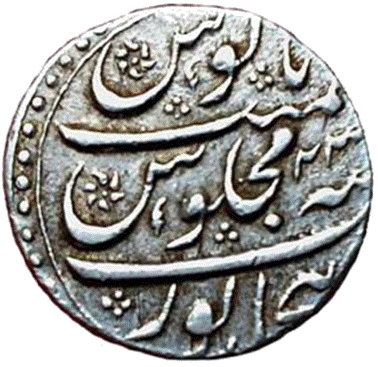|
|
|
|
Photo from Zeno 157070, posted by Lingen (from
Shailesh P Jain |
|
|
|
Note the word majulus instead
of julus
|
|
Struck at Bijapur in
the 23rd tranquil and prosperous year of reign of the now acknowledged
monarch Aurangzeb Alamgir |
|
|
Jan Lingen wrote: Majulus seems only inscribed on the rupees 1091
AH/Ry.23. Similar rupees of 1091/Ry.23 with correct inscription are known as
well (See Nagpur Museum Catalogue #1374). Coins with Ry.24 (see ONS NL#158,
p.22-23) have the correct Julus inscribed on them as well. This type of
rupee, without the mint epithet "Dar al-Zafar" was struck while
Bijapur was under siege by the Mughal army and struck as a public obedience
to the Mughal Emperor by the Bijapur government. Whether the Majulus inscription is a die-cutters error or it has a
political meaning, I just don't know, but it must be one of the earliest
issues, struck under Sikandar Shah of Bijapur,
acknowledging the Mughal emperor Aurangzeb. For further reading regarding the
historical background of the rupees of Bijapur dated 1091 AH in the name of
Aurangzeb Alamgir, see ONS-NL#158, p.22-23. In addition he wrote: Rupees without epithet were struck from 1680 (AH1091, which date
became frozen on the coins) by Sikander Shah of
Bijapur as acknowledgement of the Great Mughal. The intial issue has a peculiar
reverse formula: Zarb Bijapur Sanah Majloos Maimanat
Manus (Struck at Bijapur in the year 23 of the acknowledged monarch's
tranquil prosperity). This particular formula may have been
used to acknowledge the Mughal emperor Aurangzeb, as the ruling or sitting
monarch but still regarding themselves independent. The normal Julus formula reads as: Zarb Bijapur Sanah Jalus Maimanat Manus (Struck at Bijapur in the year 23 of his reign of tranquil
prosperity) Thanks to Admirtal Sohail Khan on the
SACG, who provided the following information regarding the reading: The word "majloos" on the
coin of Aurangzeb is an interesting phenomenon. I can offer one explanation which seems to me to fit in. My
explanation may appear a bit dry though. In Persian and in Urdu, an impersonal noun is used to make an
objective personal attribute. [I believe that the practice is same/similar in
Arabic]. This is generally always achieved by simply adding an "Meem" to the base word. Not to bore you, but
to clarify the point, I give a few simple examples which probably all those
with even working knowledge of Persian/Urdu/Hindi will quickly recognize. Hifazat ...........to.....Mahfooz
(protection to ...one who is protected or the protected one) Muhabbat ......to.....Mahboob (one who is loved, or the loved one) Ikhtiyar ...........to ....Mukhtar (one
who is given the choice) Hamd ............to .....Mahmood (one
who is praised) Khitab ............to ....Mukhatib (
one who is addressed) Majlis .............to.....Majloos (one who is sitting or made to sit) Jazb ..............to .....Majzoob (one who is
absorbed --used for Saints--Bu Ali Shah Qalandar at
Dehli) and there are so many other words in day to day use in
India/Pakistan. I must admit that I have not come across the use of word Majloos anywhere and even in dictionaries/Lughat. This derivation, however, seems very logical, and
seems to be Arabic rather than Persian. Hence, I think that the use of word MAJLOOS is not an error of
the mintmaster but a novel use of a word conveying
the same meanings. He may be hinting that 'it is a recent phenomenon ....sarcastically....that here in Bijapur Aurangzeb was
not reigning for past 23 years, but has recently
been installed/acknowledged as sitting monarch etc etc
being the hidden meaning that Aurangzeb's Jaloos
here is a recent one. It was however not an acknowledged practice in Mughal
territories and probably remained a totally isolated example. Grammatically
this word differs from JALOOS which was " a statement" to a word
that is attributed to person of Aurangzeb. The translation could also be
"Aurangzeb who has now been enthroned .........." [ again implying
---has not been in the past in 22 years..]. God only
knows the Truth. This probably becomes one of the very interesting Persian/Arabic
word used on Mughal coins.Further
information for these specific rupees see the article in the ONS Newsletter
#158 (p.22-23) "Rupees of Bijapur dated 1091H. in the name of Aurangzeb Alamgir". |
|



